Beyond the Ballpark: Exploring the Role of Baseball in Regional Tourism
Hyo Won Yoon, Senior Researcher at Yanolja Research / [email protected]
The revitalization of regional tourism has long been a priority in Korea’s tourism policy. The 6th Basic Plan for Tourism Promotion (2023–2027) seeks to usher in “an era of more frequent and longer regional stays” through measures such as issuing digital resident tourism passes, supporting workation programs, and expanding lifestyle and nighttime tourism. This reflects a policy shift toward broadening the role of everyday, experience-oriented content alongside traditional cultural and natural resources.
Within this trend, sports—particularly professional baseball—stands out for its accessibility and loyal fan base, offering strong potential to generate extended stays and local spending. In 2024, the Korea Baseball Organization (KBO) League surpassed 10 million spectators in a single season for the first time in its 43-year history. This milestone signifies not only unprecedented popularity but also a massive annual flow of people centered on franchise cities nationwide. Such momentum highlights professional baseball as a powerful tool to address chronic challenges in regional tourism, notably limited demand and the concentration of activity in the capital area.
[Fig. 1] Annual Attendance Trends in the KBO League(10,000 persons)
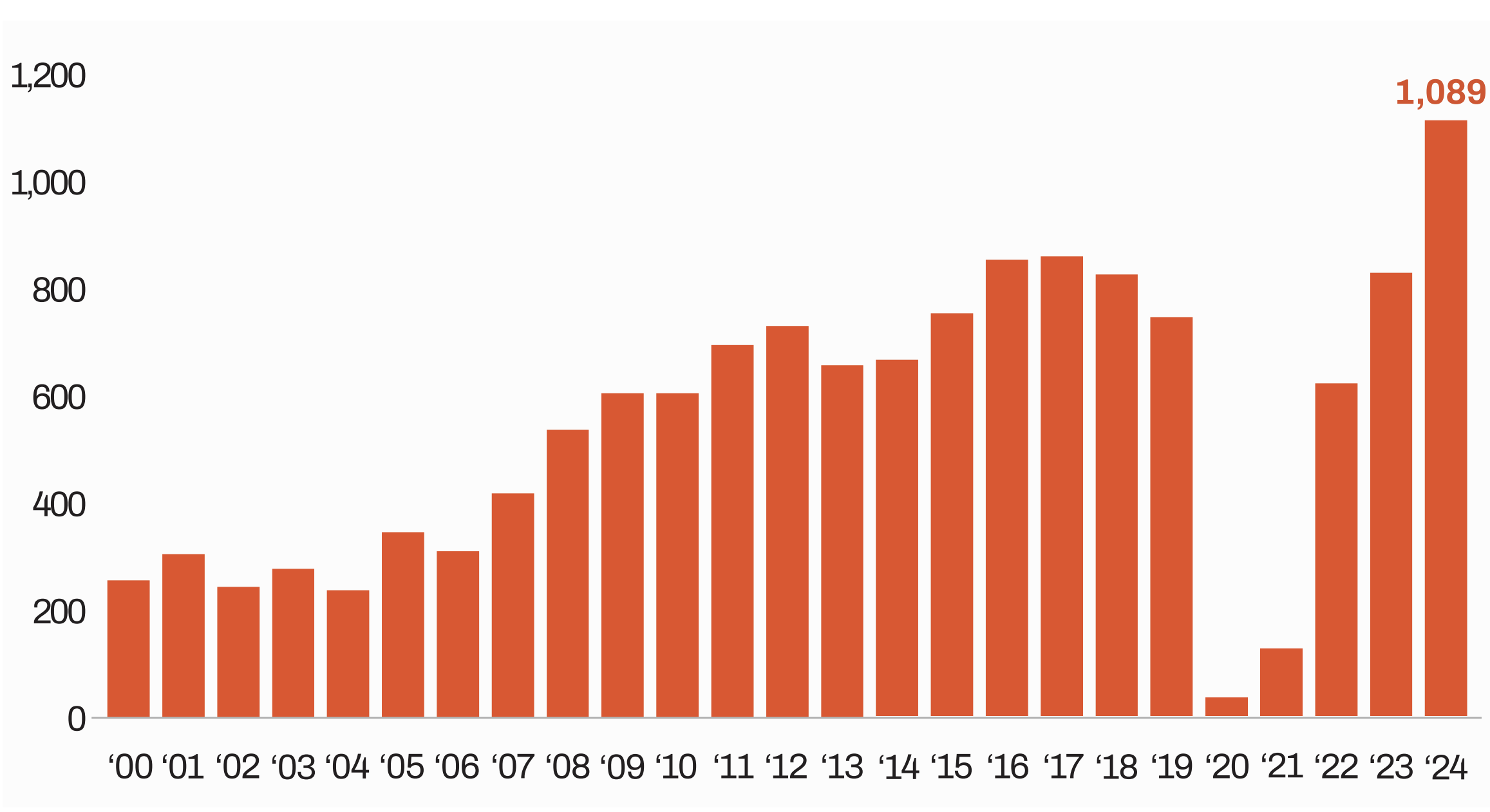
Source: KBO
Korean tourism continues to face a serious concentration in the capital region, with nearly 80% of inbound visitors staying only in Seoul and its vicinity, leaving a significant gap with other areas. Domestic tourism shows similar patterns, as demand clusters around major destinations such as Busan and Jeju while many regions struggle to attract travelers. This imbalance explains why the government invests heavily in expanding local populations and developing region-specific tourism content.
Against this backdrop, the value of professional baseball is being reconsidered. The KBO, with franchises not only in the Seoul–Incheon–Suwon metropolitan area but also in key regional hubs such as Daejeon, Daegu, Busan, Gwangju, and Changwon, inherently serves as a “decentralized tourism asset.” Its proven ability to mobilize 10 million spectators annually suggests that if even part of this audience can be converted from visitors into stayover tourists, professional baseball could inject substantial vitality into local economies.
This report explores how professional baseball can function not merely as a sporting event but as a powerful tourism resource that attracts, retains, and drives consumption in regional destinations. It analyzes fan behavior data to empirically demonstrate this potential and benchmarks successful domestic and international cases to propose concrete strategies for building a sustainable sports-tourism model, ultimately offering recommendations for the role of clubs and local governments in positioning baseball as a driver of regional tourism.
Baseball as a Tourism Asset
Sports tourism refers to a multifaceted form of travel that extends beyond simple game attendance to encompass lodging, spending, and experiential activities within local communities. Scholars generally classify sports tourism into three main categories: active sports tourism, event-based sports tourism, and nostalgia sports tourism. Professional baseball can be interpreted as content that combines both event-based and nostalgia elements: the season itself functions as a major driver of visitation, while legendary players’ uniforms, historic stadiums, and ballpark tours reinforce fans’ emotional connection. In the United States, where baseball enjoys high recognition, Major League clubs already attract tourists through stadium tours and dedicated museums. Similarly, in Japan, NPB tour packages link game tickets with accommodations, transportation, and local experiences, demonstrating notable success in developing integrated tourism products.
[Table 1] Classification of Sports Tourism
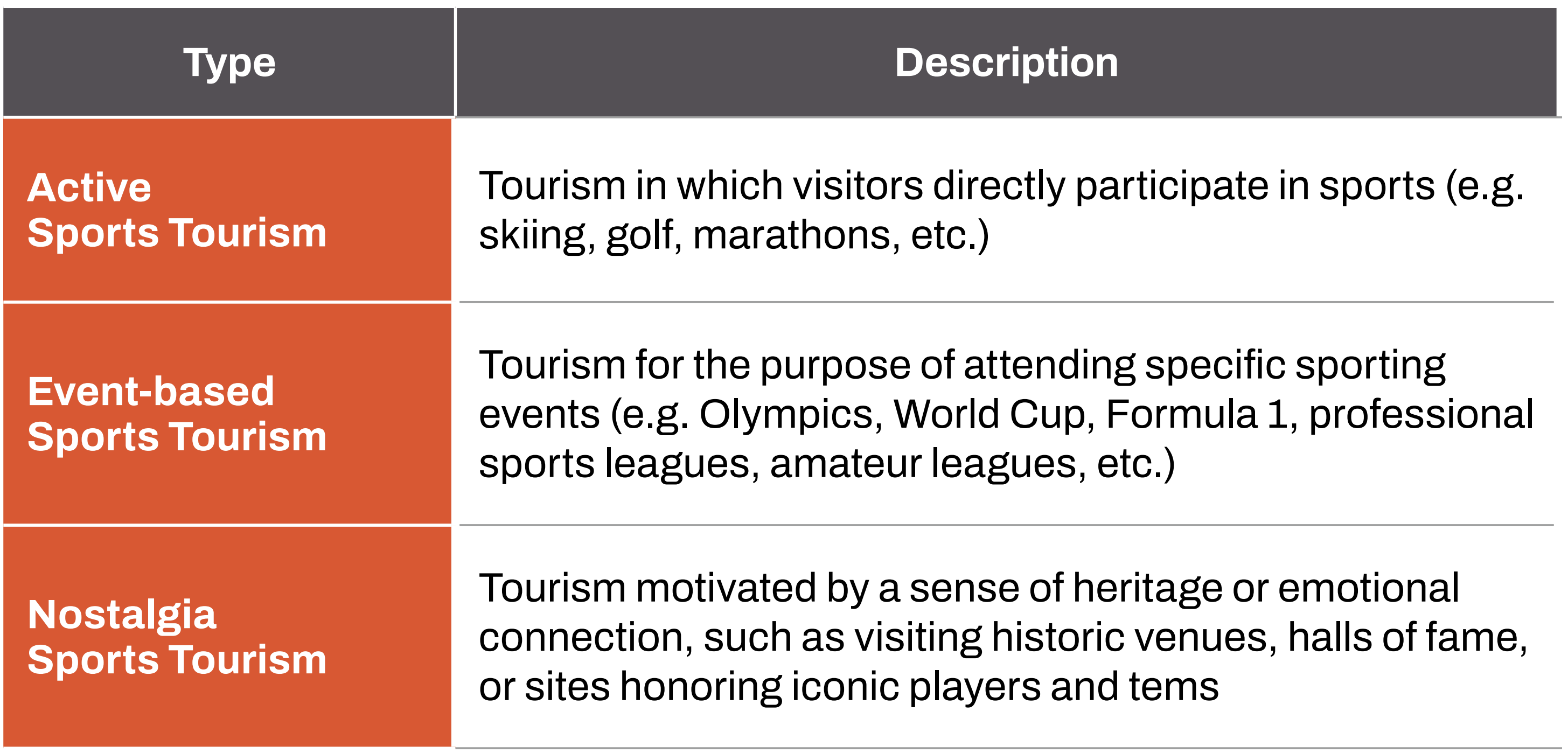
Source: Gibson(1999)
Regular, high-frequency sporting events create repeated opportunities for regional visitation, and research on event tourism consistently emphasizes how such temporal portfolios amplify local economic impact. In this sense, the density of game schedules serves as a mediator that transforms mere spectatorship into extended stays and consumption. Applied to the Korean context, this mechanism suggests that professional baseball can be closely linked to regional tourism revitalization.
Because KBO franchises are distributed nationwide, the league naturally aligns with regional tourism. Fans traveling for away games often extend their visits by dining at local restaurants or exploring attractions, thereby increasing both their length of stay and local spending. For municipalities, integrating games with festivals or tourism products built around stadiums not only strengthens place branding but also provides baseball fans with a richer sports-tourism experience beyond the game itself.
Do KBO fans in fact travel to non-metropolitan areas for games? Data from 2024 confirms this trend: provincial stadiums such as those of the Kia Tigers and Samsung Lions recorded remarkable growth, with year-on-year attendance increases of 30 to 70 percent. Payment data from BC Card further shows that while home-game attendance rose 18 percent, away-game attendance jumped 43 percent, with visiting fans spending more per capita than local spectators.
[Fig. 2] Attendance by Stadium(10,000 persons) and YOY Growth(%)
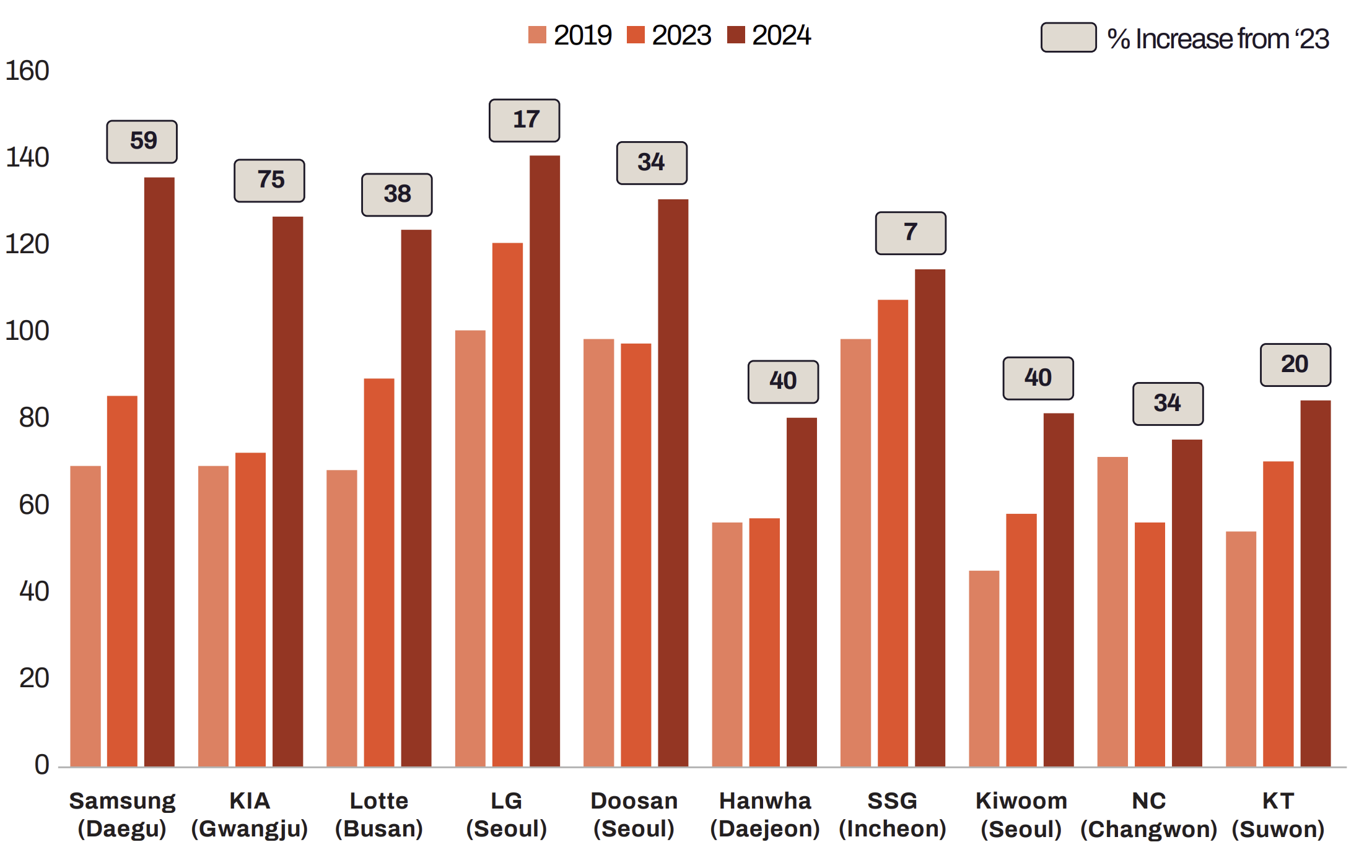
Source: KBO
Compared with other professional sports leagues in Korea, professional baseball consistently outperforms in key indicators: number of regular-season games (720 annually), average spectators per game (15,122), average visits per fan per season (15.1), and per-visit spending (49,854 KRW). These figures highlight not only the abundance of viewing opportunities but also the repetitive mobility of fans and their significant spending capacity.
As a result, professional baseball can be regarded as the sport with the strongest potential for integration with tourism among Korean professional leagues. This aligns closely with national policy directions that emphasize stayover tourism and positions baseball as an optimal partner in advancing regional tourism strategies.
[Table 2] Comparison of Korean Professional Sports Leagues(2024)
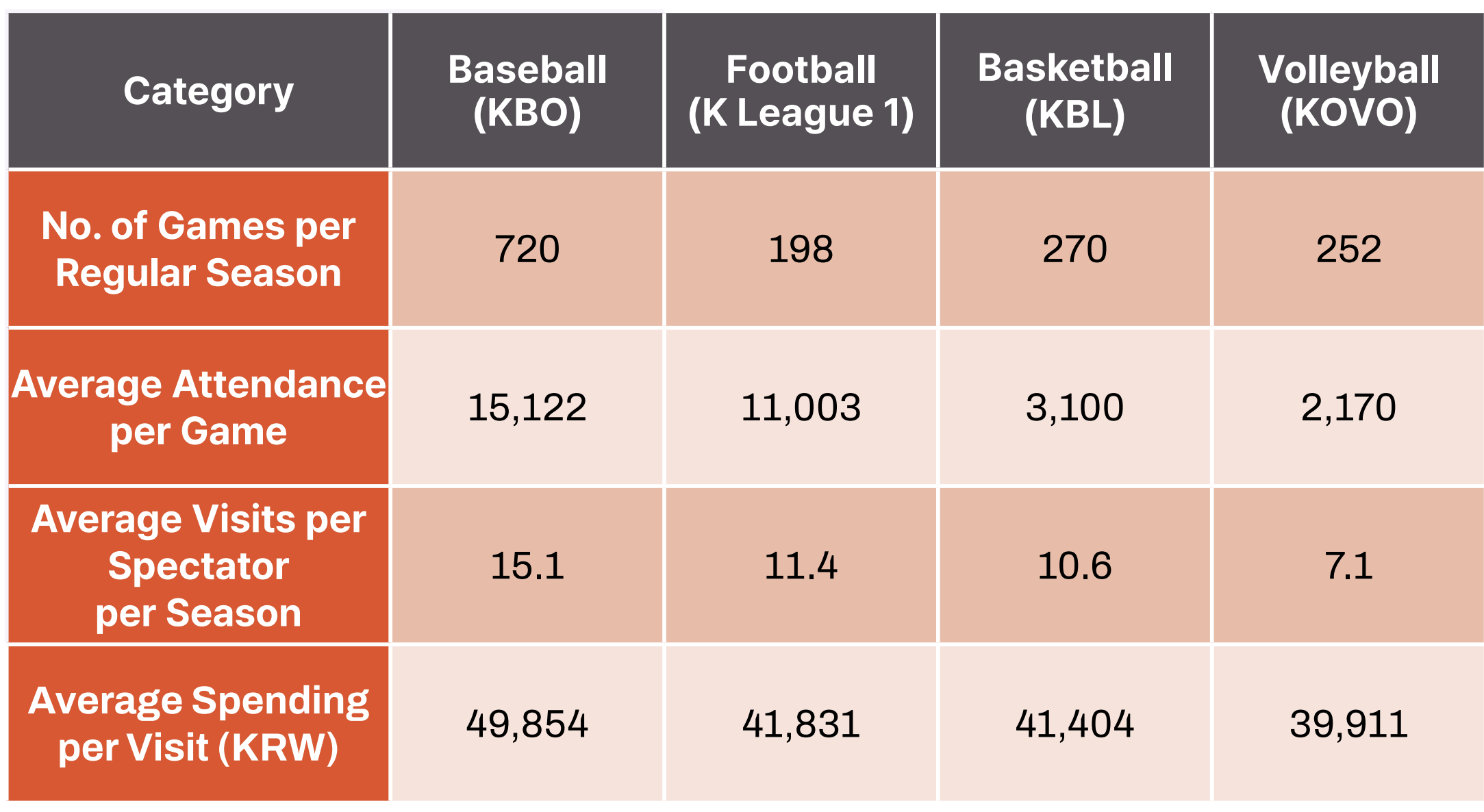
Source: KBO, K League, KBL, KOVO, KPSA
How the KBO League Drives Local Economies
Previous studies estimate that the economic impact generated by the KBO exceeds 1 trillion KRW, encompassing induced production, value added, and employment. These findings highlight professional baseball’s role as more than a sports league, functioning as a central driver of regional economies.
Such macro-level effects are even more visible in stadium-adjacent commercial districts. According to KB Kookmin Card’s 2025 transaction data, sales in areas surrounding ballparks increase by an average of 90 percent on game days compared with non-game days—31 percent higher than in 2022. This “hyperlocal economic effect” is particularly pronounced outside the capital region. For example, in 2025 the area around Hanwha Life Eagles Park in Daejeon recorded post-game sales 46 percent higher than three years earlier, the fastest growth among all stadiums nationwide. The results suggest a virtuous cycle in which improved team performance and growing fandom translate directly into small business revenue. Thus, professional baseball operates simultaneously as a macro-level economic engine and a micro-level catalyst that energizes neighborhood economies.
However, these benefits are not distributed evenly. Some local merchants report limited gains, noting that fan spending often concentrates on the stadium itself or a few nearby facilities. Without intentional strategies to broaden consumption across districts, this imbalance can lead to what may be termed “spillover inequity.” The central policy challenge, therefore, is to channel the massive game-day foot traffic into sustainable vitality for the entire local economy.
Consumption, Stay, and Tourism Behaviors of Professional Baseball Away Spectators in Non-Metropolitan Stadiums
The previous section examined the structural mechanisms through which professional baseball stimulates regional economies, yet this does not automatically translate into regional tourism development. The critical question is whether spectators—particularly away fans—who travel to non-metropolitan stadiums actually engage in extended stays and tourism activities.
Verifying whether away fans already practice “DIY sports tourism” by independently exploring destinations and spending locally, and identifying the patterns of such behavior through empirical data, represents a crucial first step toward cultivating this latent market. To this end, this study conducted a survey to capture the behaviors of professional baseball fans when visiting non-metropolitan ballparks.
[Table 3] Survey Design
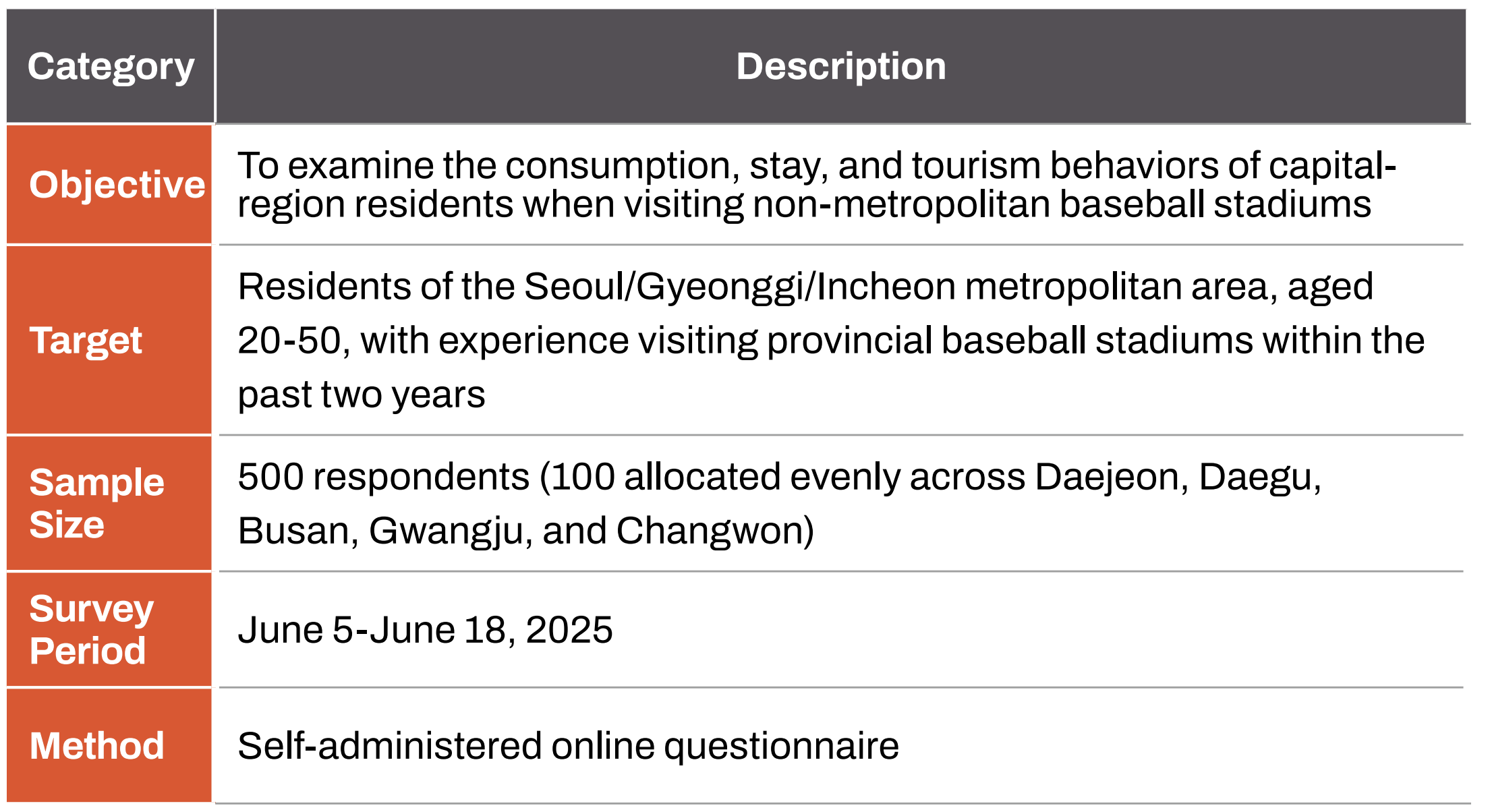
Analysis 1: Pre-Game Activities – Local Consumption Already Underway
An analysis of pre-game activities among capital-region fans visiting non-metropolitan stadiums indicates that away spectators were already actively engaging in local consumption and experiences. The most common activities included purchasing snacks or meals (76%) and visiting local restaurants and cafés (60%), demonstrating significant direct contributions to food and beverage spending near stadiums.
Other behaviors—such as visiting nearby attractions (36%) or purchasing local specialties (15.6%)—illustrate how fan activity extends beyond spectating to encompass regional tourism. Club-related spending, including the purchase of uniforms and merchandise (38.4%), also contributed to local economies. Notably, only 1.6% of respondents reported “doing nothing,” underscoring that almost all fans participated in some form of local consumption before games.
[Fig. 3] Pre-Game Activities(%)
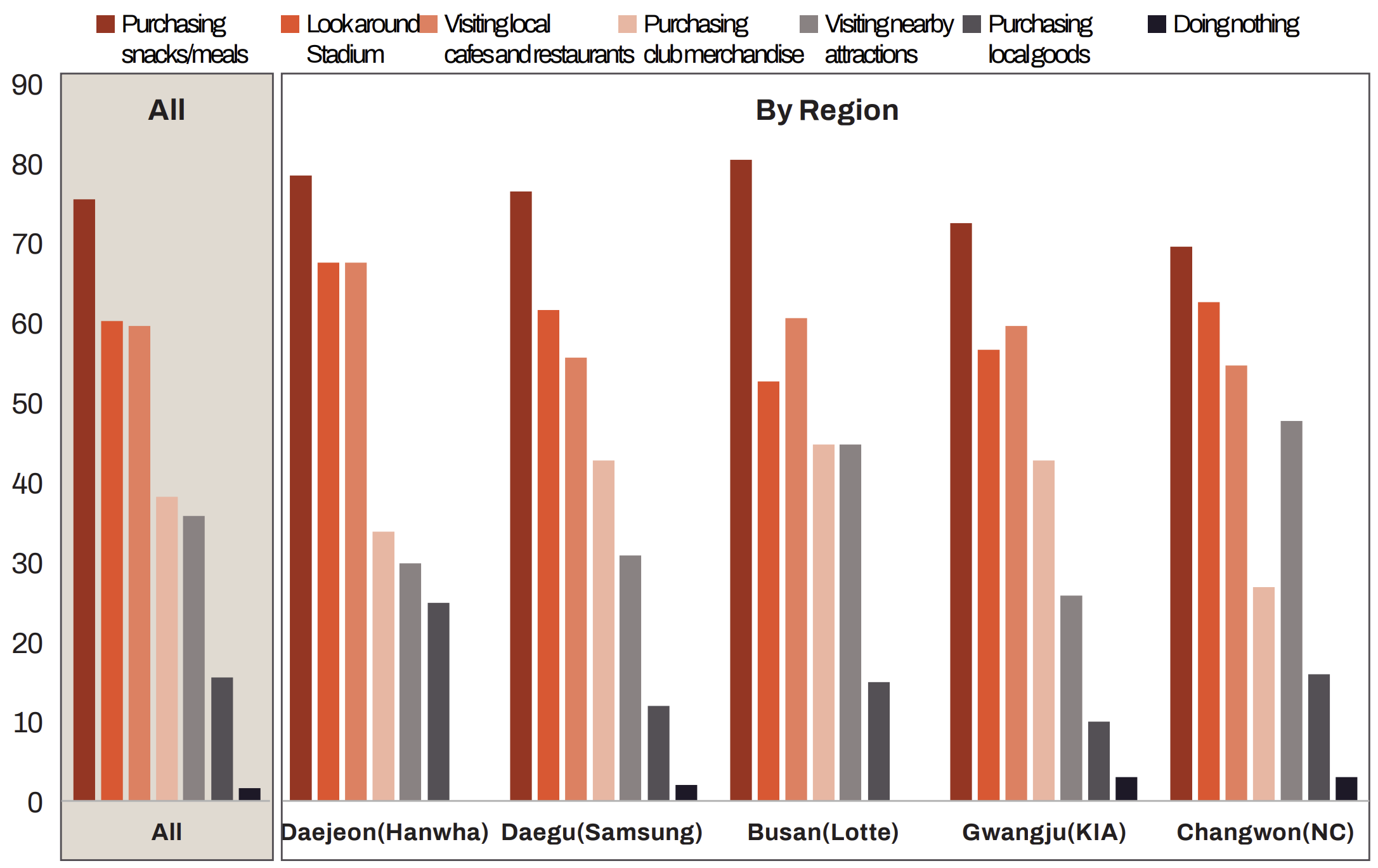
Analysis 2: Post-Game Activities – Extending the Stay
Post-game behavior also revealed clear patterns of local consumption and exploration. Nearly half of fans engaged in dining at local restaurants or cafés (46.2%), while 40.6% visited pubs, directly contributing to the night-time economy. In cities with rich tourism and nightlife infrastructure—such as Busan (pubs 52%, restaurants/cafés 53%) and Changwon (pubs 47%, attractions 28%)—these figures were notably higher. Conversely, the proportion of fans who returned directly home or to accommodations without further activity remained relatively low, around 20 percent on average, indicating that most spectators extended their presence in local areas after games.
These findings suggest that professional baseball functions not only as a sporting spectacle but also as a catalyst for dining and nighttime tourism. However, in Daejeon (34%), where proximity to the capital region makes return travel easier, fans were less likely to stay, resulting in a higher share of spectators who left without additional consumption or tourism.
[Fig. 4] Post-Game Activities(%)
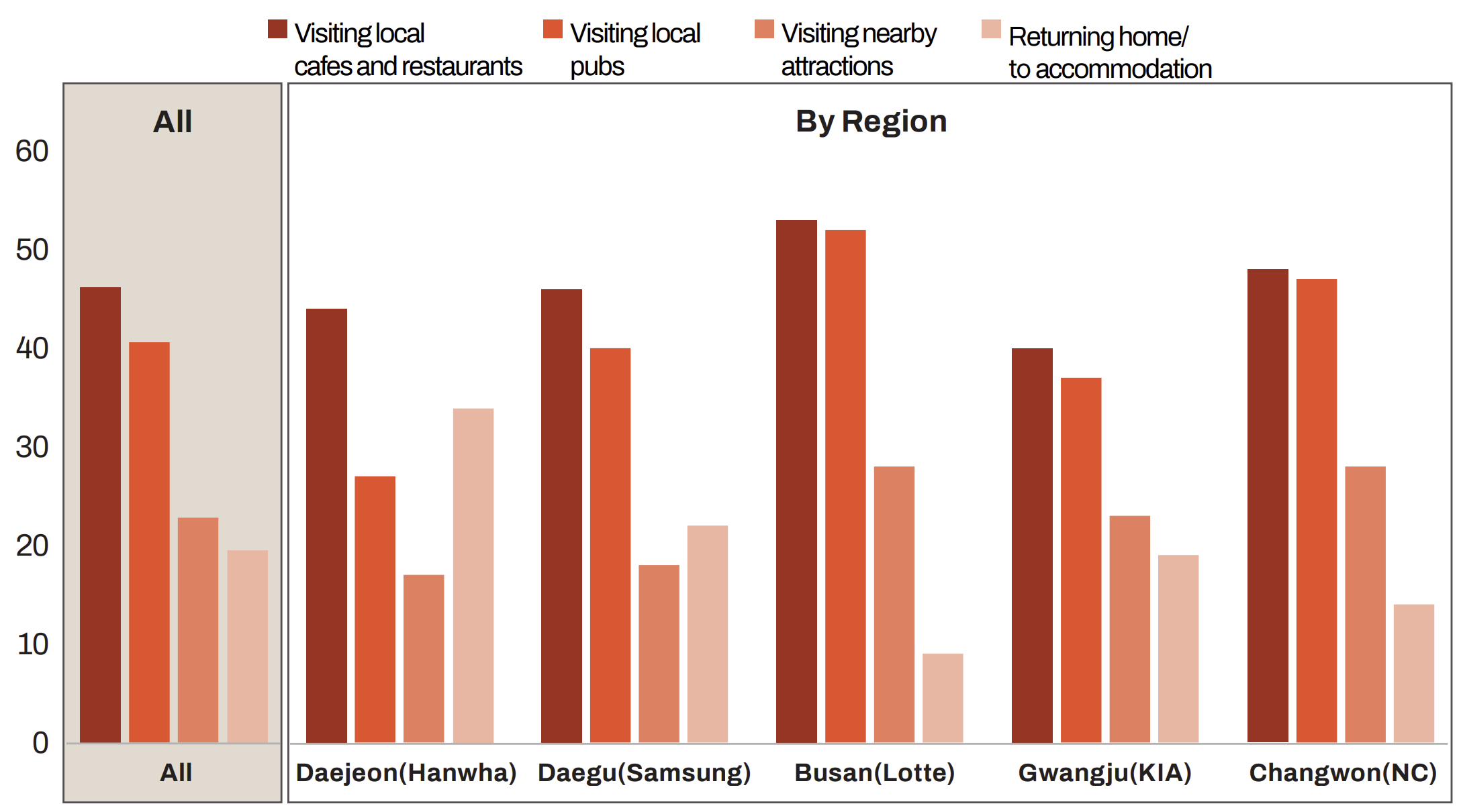
An analysis of overnight stays following Friday and Saturday games shows a strong correlation with distance from the capital region. In Daejeon, located about 170 km from Seoul, only 50 percent of fans stayed overnight. In contrast, destinations more than 300 km away recorded sharp increases, with Busan (400 km) showing the highest conversion rate at 86.8 percent, followed by Gwangju (73.2%) and Changwon (75.3%).
These findings indicate the existence of a clear “distance threshold.” Cities within roughly 200 km of Seoul allow for same-day return travel, whereas those located beyond 300 km see a decisive shift toward overnight stays. In other words, away-game attendance in professional baseball tends to merge with stayover tourism once this threshold is crossed. Recognizing this, local governments must consider their geographic distance and transport infrastructure (e.g., KTX rail) when designing tailored tourism strategies.
[Fig. 5] Distance from Seoul Station(km) VS. % of Overnight Stays of Fridays and Saturdays
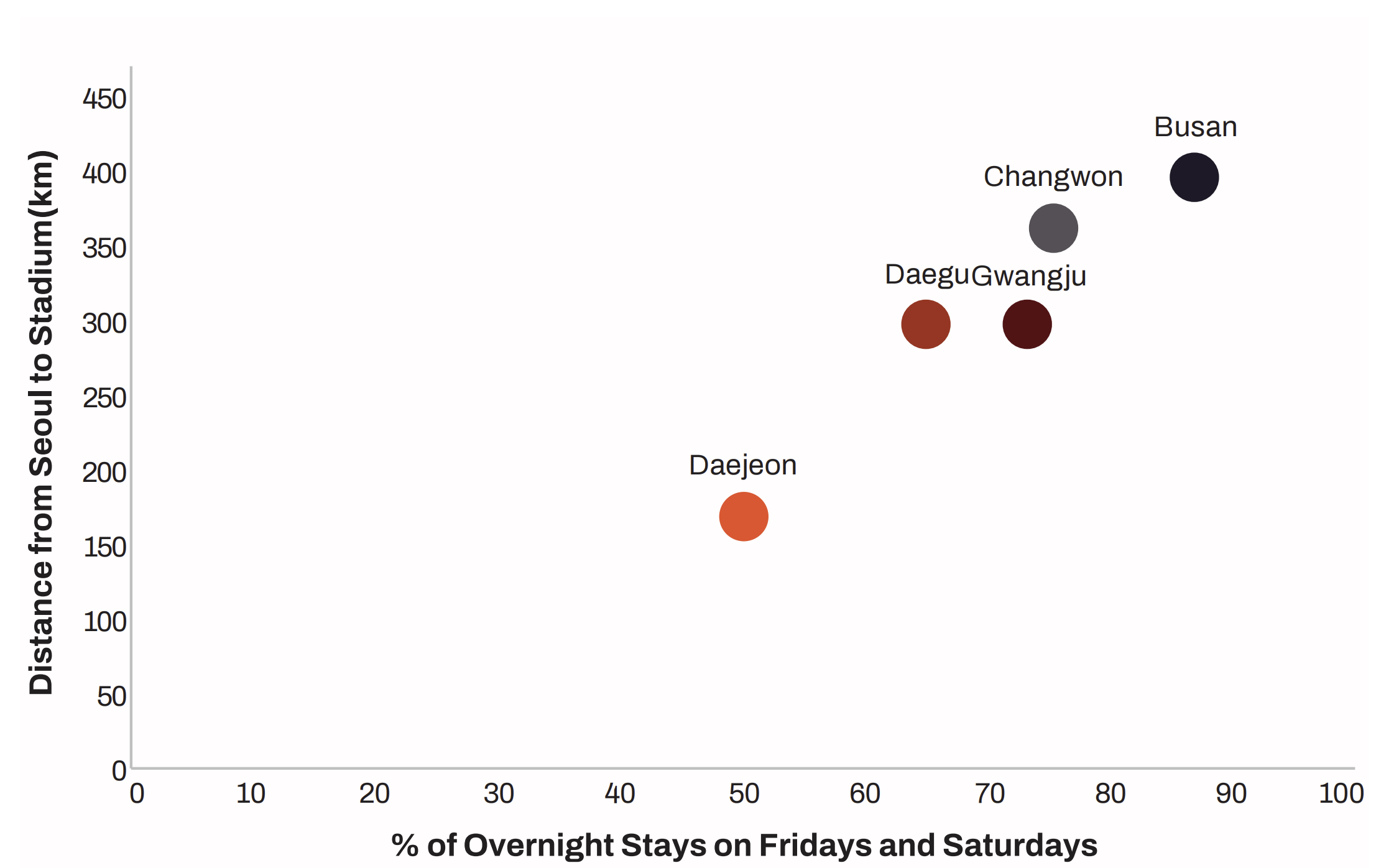
Analysis 3: From Spectators to Tourists
Game attendance frequently expands into tourism. Only 22.4 percent of respondents reported “no tourism,” meaning the vast majority visited at least one attraction. In Busan, 67 percent of fans visited two or more sites and 16 percent visited four or more, while in Changwon the figures were 52 and 8 percent respectively. Daegu also showed high multi-destination activity (30 percent for two sites, 10 percent for three, 8 percent for four or more). By contrast, Daejeon and Gwangju recorded relatively higher shares of single-site visits. These results demonstrate how away-game attendance often translates into extended regional tourism.
The findings further indicate that away fans are already engaging in a form of “DIY sports tourism,” voluntarily combining baseball games with local exploration. With systematic tourism products and better information, this latent demand could be converted far more effectively into tangible tourism consumption.
[Fig. 6] Number of Tourist Sites Visited(%)
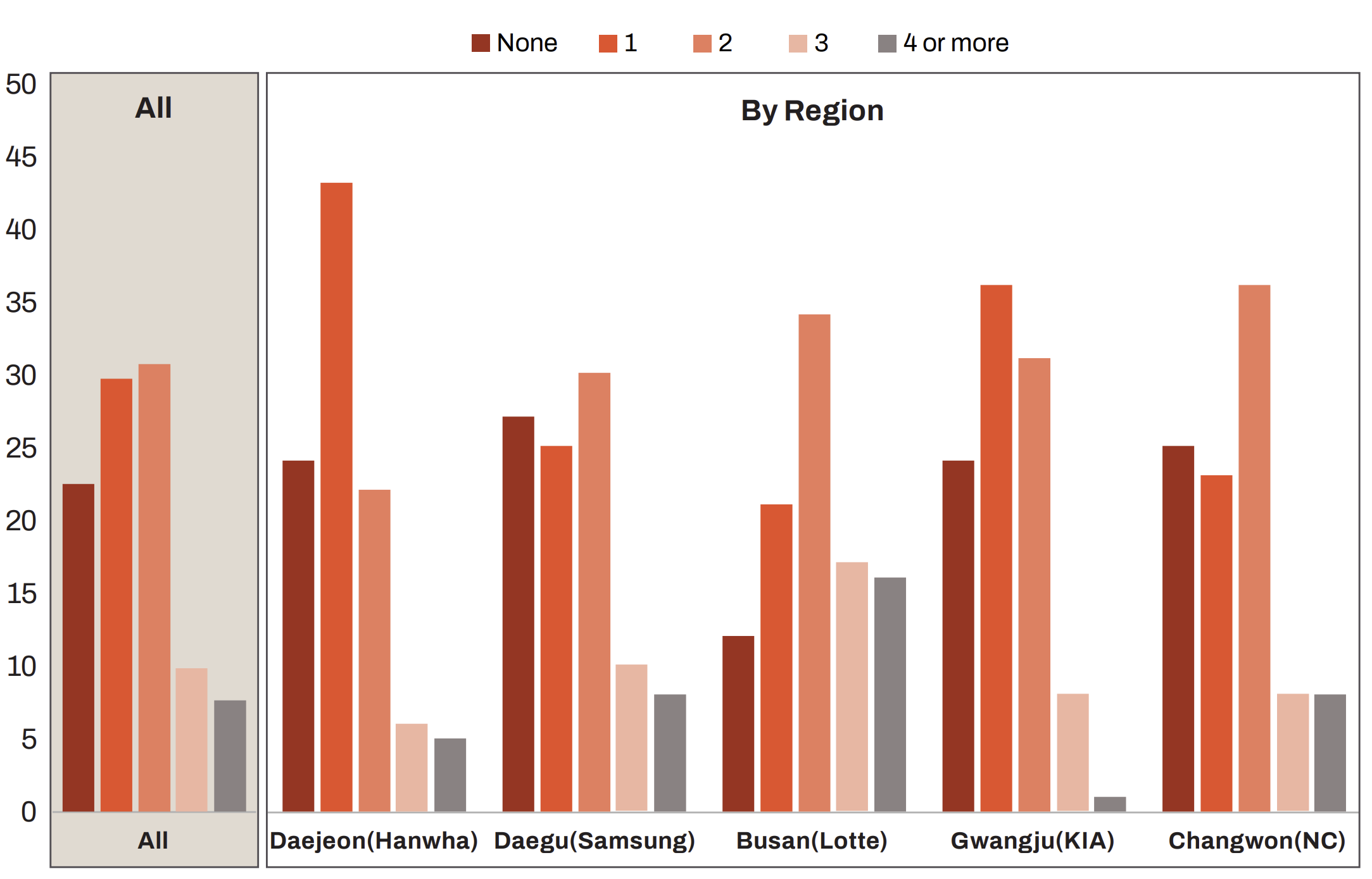
Regional Differences in Spectator Behavior
As shown above, visits by capital-region fans to provincial stadiums extend beyond viewing games to include local stays and spending, though patterns differ markedly by city. Busan and Changwon emerged as the most representative models of stayover tourism, with balanced pre- and post-game consumption and high rates of multi-destination visits, demonstrating how baseball attendance naturally converts into tourism. Daegu displayed a similar pattern, particularly in terms of vibrant nighttime activity. Collectively, away fans combined stadium experiences with dining, pub visits, and multiple tourist sites, highlighting the potential expansion into stayover tourism.
By contrast, Daejeon and Gwangju showed shorter-stay tendencies. In Daejeon, proximity to the capital region and convenient KTX access facilitated same-day returns, leading many fans to depart shortly after dining despite attending games. Gwangju, while strong in dining and pub activity, recorded limited tourist site visits, reflecting smaller-scale tourism. Overall, provincial stadium attendance contributes to regional tourism, but the intensity of stayover tourism varies according to location and stadium characteristics, underscoring the need for region-specific strategies.
[Table 4] Regional Characteristics of Spectator Behavior
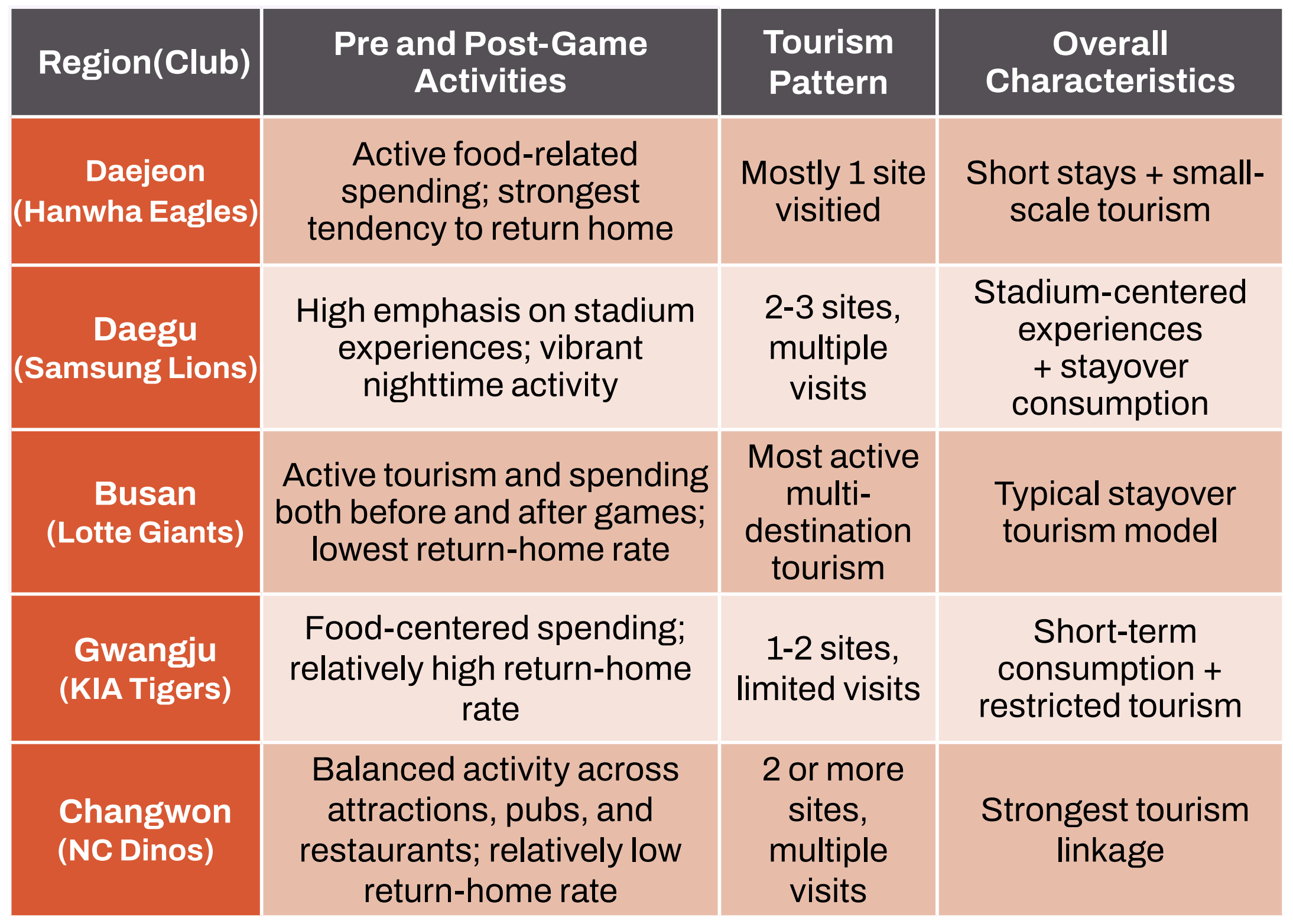
Three Strategic Approaches for Promoting Tourism through Professional Baseball: Global Benchmarking
The preceding survey analysis demonstrated empirically that away fans visiting non-metropolitan stadiums can be converted into stayover tourists who not only attend games but also stay overnight, spend in local commercial districts, and visit attractions. To expand these consumption patterns and develop strategies for regional tourism promotion, it is essential to examine strategic initiatives observed in advanced international cases. A review of such cases suggests that approaches to leveraging professional baseball for tourism development can be broadly categorized into three models.
[Fig. 7] Types of Tourism Promotion Based on Global Best Practices

Strategy 1: Transforming Ballparks into Landmarks
The first model involves repositioning the stadium itself as a tourist destination. Rather than functioning solely as a sports facility hosting roughly 72 games per year, the stadium is redefined as a year-round city landmark and multi-purpose entertainment hub.
Major League Baseball franchises in the United States have long pursued this strategy. The New York Yankees, for example, operate stadium tours available on non-game days, during which visitors can experience the Yankees Museum and Monument Park, viewing legendary players’ uniforms, monuments, and historical artifacts. Beyond the standard tour, a wide range of personalized products is offered—from photo packages commemorating birthdays, baby showers, and graduations, to proposal events for couples, and private tours and venue rentals for corporate groups.
Such tours extend beyond passive viewing, allowing visitors to create personal experiences within the team’s history and symbolism. This case illustrates how a sports stadium can operate as a cultural and tourism asset for the city.
[Fig. 8] New York Yankees' Stadium Tour
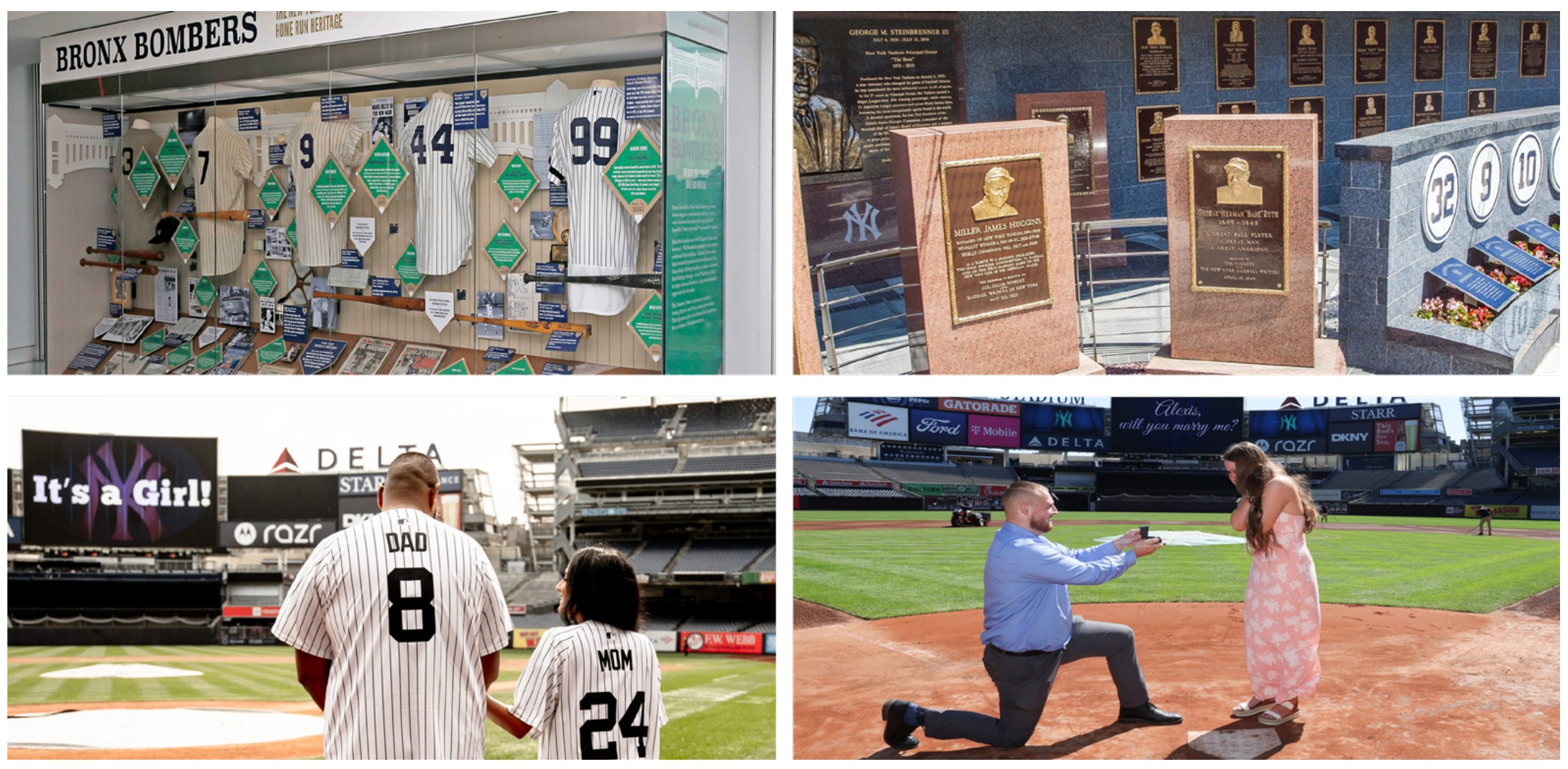
Source: New York Yankees
In Japan, several cases demonstrate how ballparks integrate entertainment elements to attract visitors even on non-game days. Rakuten Mobile Park in Miyagi Prefecture exemplifies this approach, promoting the concept of a “ballpark” as a family-friendly tourist destination.
Part of the stadium has been developed as “Smile Glico Park,” designed like a theme park with a Ferris wheel and carousel, encouraging families to spend time there regardless of game schedules. In addition, instead of standard concessions, the venue operates a “Local Food Hub” featuring regional agricultural products, allowing visitors to experience local flavors. These initiatives transform a ballpark visit from mere spectating into a tourism experience that connects directly with regional culture.
[Fig. 9] Rakuten Mobile Park Miyagi

Source: Rakuten Mobile Park Miyagi Wikipedia
The Hokkaido Nippon-Ham Fighters’ Es Con Field serves as the centerpiece of “F Village,” a multi-purpose complex integrating hotels and retail. Its Tower 11 Hotel is the first in Asia designed with guestrooms and a rooftop that directly overlook the field, allowing views even on non-game days.
Guests can relax in the third-floor hot spring and sauna while enjoying a full view of the stadium, or watch games from semi-outdoor “Totonoë Terrace Seats” during sauna sessions. These features establish the facility as a stayover entertainment hub for both fans and general visitors.
[Fig. 10] Tower 11 Hotel at F Village
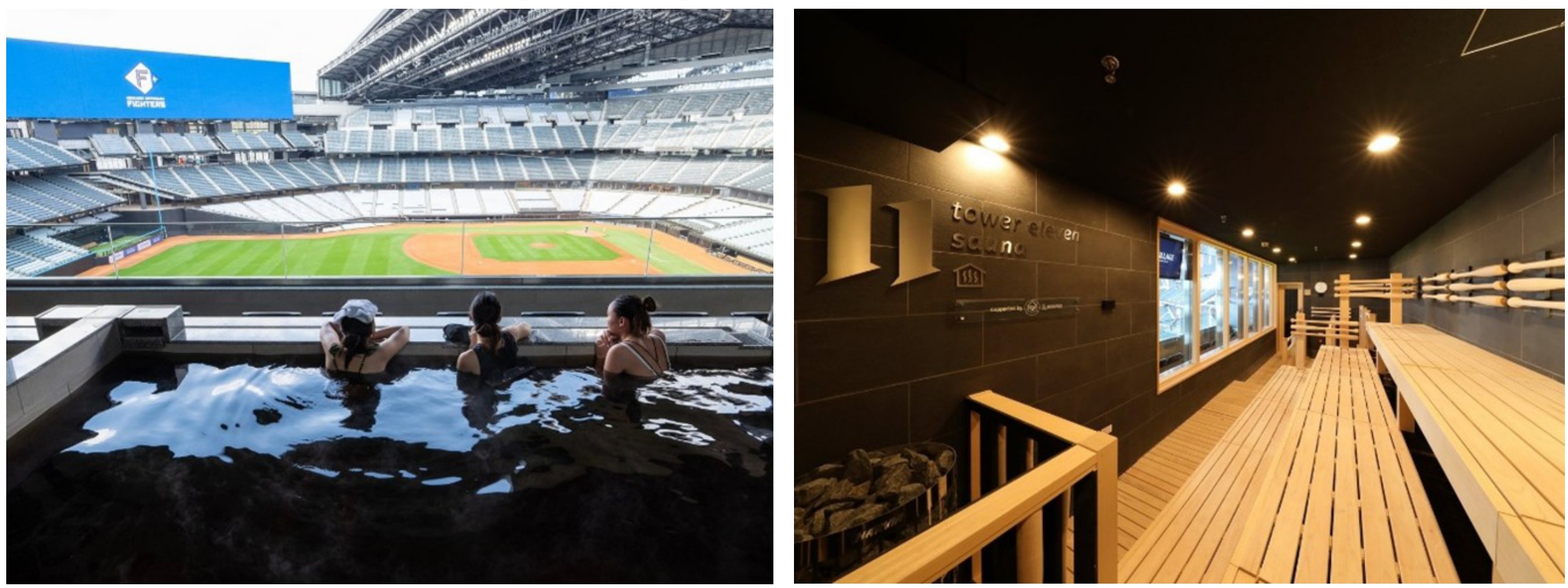
Source: Hokkaido Nippon-Ham Fighters
Efforts to utilize baseball stadiums in more diversified ways are also emerging in Korea. The Hanwha Life Eagles Park in Daejeon, which opened in 2025, was designed from the outset to serve as a large-scale concert venue accommodating up to 20,000 people during the off-season. In addition, parks and recreational sports facilities have been developed around the stadium to function as everyday leisure spaces for local residents.
Similarly, the City of Busan is pursuing the reconstruction of Sajik Baseball Stadium with the goal of transforming it into a multi-purpose cultural complex that goes beyond its role as a sports venue. Such “landmarking” strategies expand the function of ballparks beyond game days, offering unique experiences to both fans and tourists, while simultaneously enhancing the city’s overall tourism appeal.
Strategy 2: Developing Integrated Tourism Packages
The second model focuses on creating comprehensive travel packages that combine baseball games with transportation, accommodation, and regional cultural content. This approach systematizes the spontaneous “DIY sports tourism” demand identified in the earlier survey, enhancing convenience for fans while more effectively channeling their spending into the local economy.
Several Major League Baseball teams have pursued such product development independently. The Seattle Mariners, for instance, launched the “Mariners Vacations” program, offering a four-day, three-night package that integrates game attendance with activities such as brunch with team representatives, local excursions, and hotel accommodations—enabling participants to experience “spectating plus travel” as a single offering. Similarly, the San Francisco Giants introduced packages such as “Motor City Magic” (a five-day trip to Detroit), “Visit the Windy City” (Chicago), and the “East Coast Swing” tour (New York and Philadelphia), thereby lowering barriers for long-distance away-game attendance.
[Fig. 11] Mariners Vacations
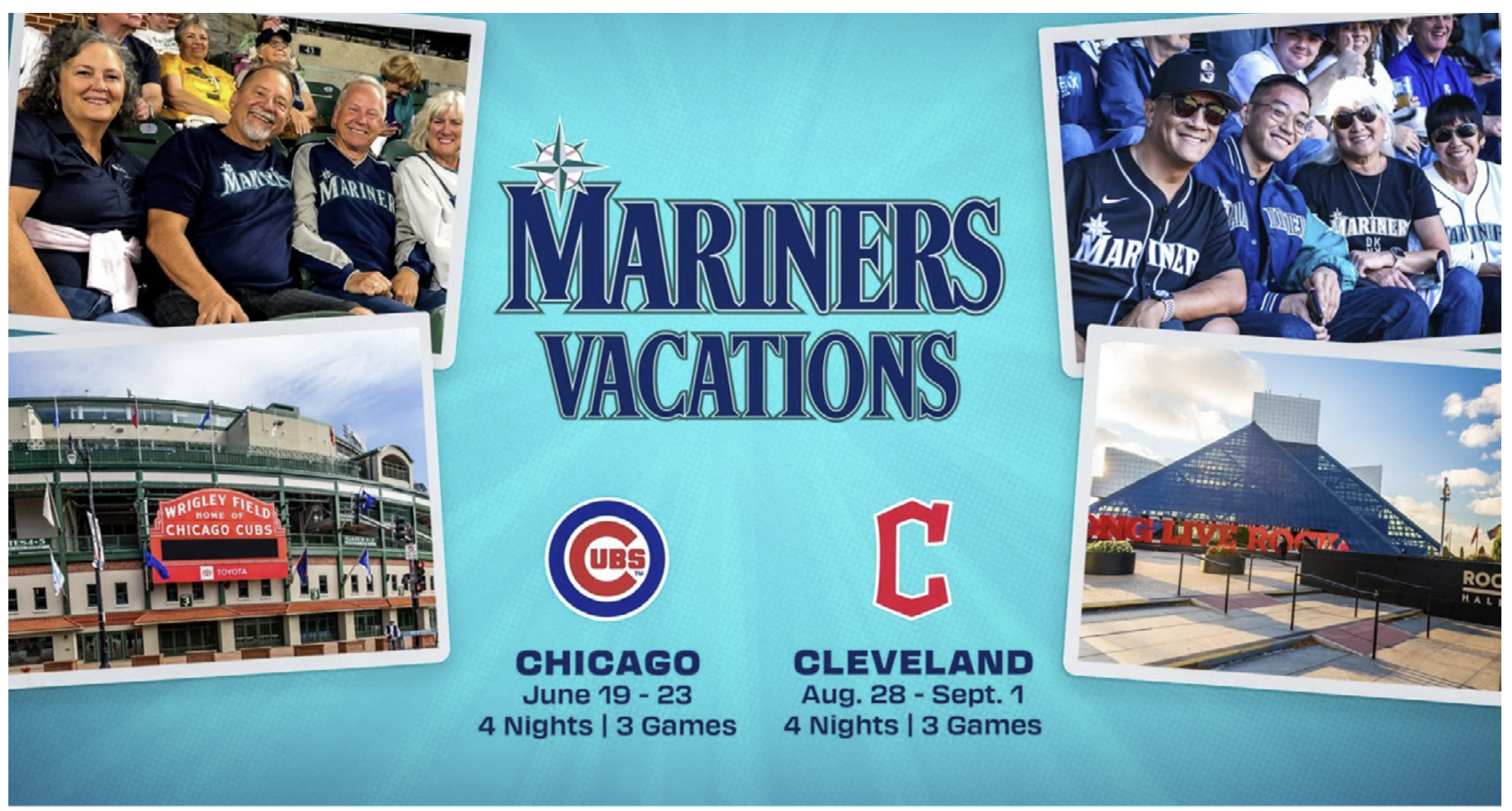
Source: Seattle Mariners
Collaboration between professional baseball clubs and the hospitality sector is also noteworthy. In Boston, Hotel Commonwealth partners with the local Red Sox to offer a “Red Sox Game Package,” which includes premium game tickets, a VIP stadium tour, and autographed memorabilia. Similarly, the Omni San Diego Hotel has introduced a “Baseball Experience Package” in partnership with the Padres, featuring direct access to the stadium via a skybridge, a $50 food and beverage credit, and welcome amenities such as local craft beer and light snacks.
In Japan, the approach goes beyond combining lodging and tickets, transforming the accommodation itself into a fan-centered experience. The Tokyo Dome Hotel, leveraging its proximity to the Yomiuri Giants’ home stadium, offers collaboration rooms such as “The Legends Room” for long-time fans and the more playful “Go Giants! Room.” Guests receive exclusive keepsakes, including a specially designed room key and spa bag, while on game days, packages combining accommodation and tickets are available.
The Yokohama Bay Sheraton Hotel & Towers similarly runs “BayStars Concept Rooms” in collaboration with the Yokohama DeNA BayStars. These feature player-signed uniforms, team-branded bedding and amenities, mascot plush toys, and even morning calls recorded by players. Additional perks include commemorative mugs and bottles, while packages with tickets provide two reserved infield seats and breakfast. Such offerings act as destination-type products, enticing even distant fans to plan trips they might otherwise forgo.
[Fig. 12] Yomiuri Giants Themed Room at the Tokyo Dome Hotel

Source: Tokyo Dome Hotel
In this way, baseball-linked tourism products, by integrating games, transportation, and lodging, reduce barriers to trip planning and enhance accessibility, while enabling host cities to maximize the economic benefits of stayover tourism.
Strategy 3: Building Symbiotic
For the strategies of “stadium landmarking” and “tourism package development” to take root successfully, a stable and trust-based partnership between baseball franchises and local governments is essential.
The United States offers instructive examples, often framed as city- or state-level branding campaigns. A representative case is New York State’s collaboration with the Yankees and Mets on the “I LOVE NY Baseball” campaign, which integrated team brands into the state’s official tourism slogan, positioning stadiums as focal points of New York travel. The campaign’s website connected ballpark visits with nearby restaurants and cultural attractions, thereby converting game attendance into a broader urban stay.
Similarly, during the 2024 MLB London Series, the Philadelphia Convention and Visitors Bureau (PHLCVB) promoted the city by showcasing its key attractions and launching tailored travel packages in partnership with tour operators. Such initiatives illustrate how league-level games and events can serve as international platforms for amplifying regional identity through synergy with tourism boards.
[Fig. 13] New York State Government's “I LOVE NY” Campaign
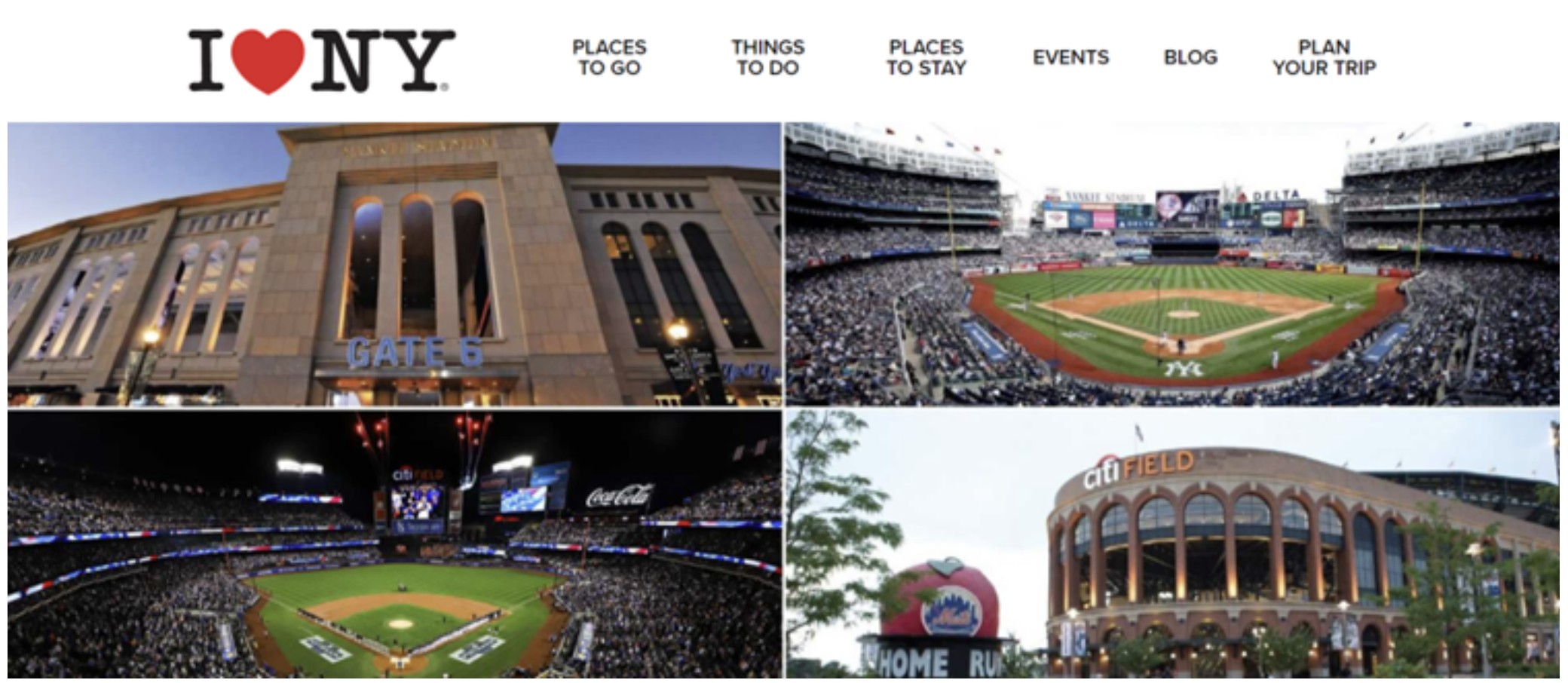
Source: I LOVE NY
In contrast, Japan has pursued a dual strategy, combining government-led efforts to expand into overseas markets with club-level initiatives for domestic regional promotion. Since the mid-2010s, the Japan National Tourism Organization (JNTO) has worked closely with Nippon Professional Baseball (NPB), leveraging the sport as a tool for attracting foreign visitors. A notable example is the “Visit Japan Day” event targeting Taiwan, where Japanese teams played exhibition games, operated cultural experience booths, screened tourism videos, and promoted baseball-linked travel packages. This effectively conveyed the message of “experiencing Japan through baseball” and positioned the sport as a gateway for inbound tourism.
Domestic-facing campaigns have been more locally embedded. The Hiroshima Toyo Carp, for instance, operates the “Carp Pilgrimage” in partnership with the Hiroshima Prefecture DMO, guiding visitors through a model course that includes the team museum, shops, and monuments. The Carp’s iconic “red” identity has become inseparable from the city brand, reinforcing the equation of Carp = Hiroshima. Similarly, the Chiba Lotte Marines have run the “ALL FOR CHIBA” project since the early 2000s, transforming games into platforms for promoting the prefecture’s municipalities and specialties. Each home game highlights a different local area, distributing regional products and operating promotional booths. Fans thus experience the breadth of Chiba’s culture while attending games, making the stadium a standing stage for local branding.
Through such partnerships, Japanese clubs place baseball at the forefront of urban marketing and regional identity-building.
[Fig. 14] The “Hiroshima Toyo Carp Pilgrimage” Route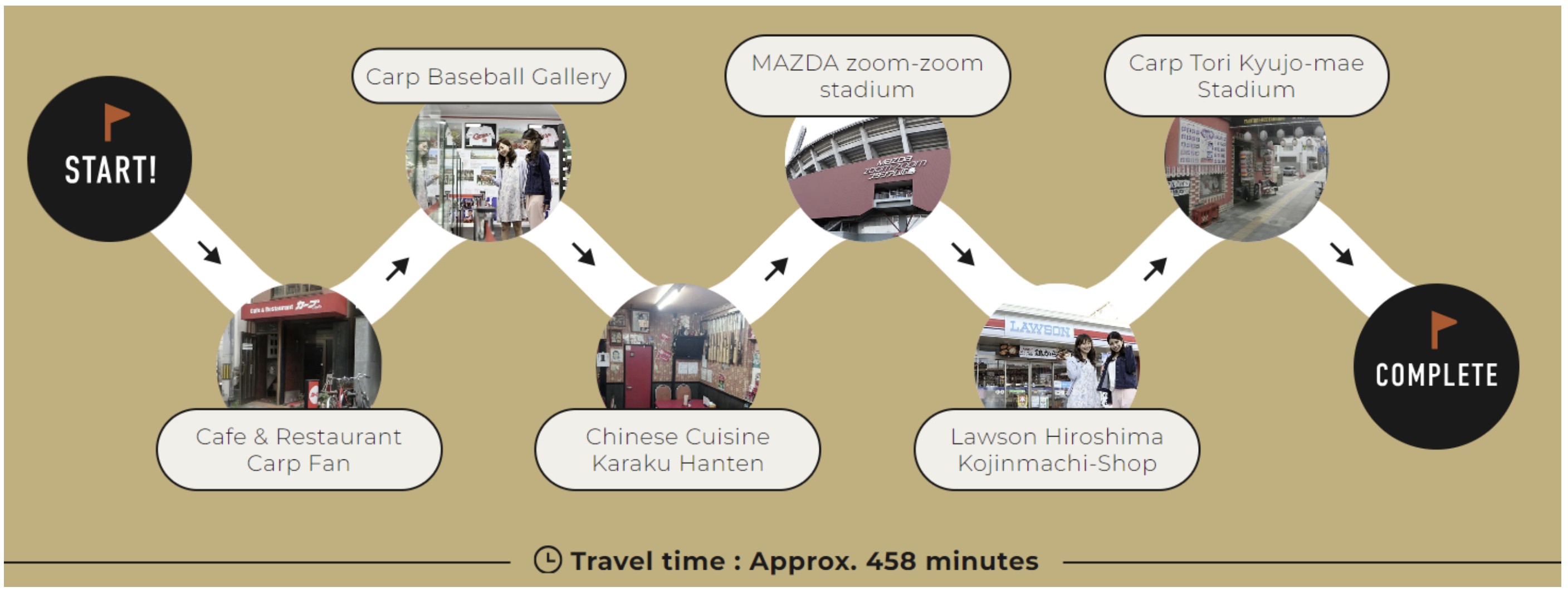
Source: Hiroshima Tourism Association Dive!
In South Korea, collaboration between municipalities and baseball clubs has also gained traction, though the emphasis differs from the U.S. and Japan in focusing primarily on domestic tourism. For example, Gwangju Metropolitan City, home of the KIA Tigers, launched the “Baseball Enthusiast Trip” in connection with the “2025 Visit Gwangju Year,” combining KIA Champions Field with major attractions, KTX discounts, and hotel benefits. Similarly, Changwon City partnered with the NC Dinos to introduce tour pass + ticket packages, seamlessly linking fan mobility with urban tourism experiences.
Although the three strategic approaches vary in design, they converge on a common goal. Stadium landmarking positions the ballpark as a tourist attraction; tourism package development places baseball at the core of travel planning; and city–club partnerships extend sport into the domain of urban branding. Collectively, these efforts underscore that professional baseball is more than a sport—it can function as a conduit for shaping destination appeal and fostering stayover tourism.
New Horizons: K-Cheering Culture and the Opportunity of Global Fandom
While earlier strategies emphasized regional tourism driven by domestic away fans, attention must now turn to the growing potential of attracting international visitors. The KBO League has recently gained recognition as a distinctive form of “K-content,” owing to its globally unparalleled cheering culture.
Unlike Major League Baseball in the United States, which focuses primarily on the game itself, or Japan’s NPB, where cheering is largely organized by specific supporter groups, the KBO features a club-led, fully participatory style in which fans collectively sing and dance throughout the game. This festive and immersive atmosphere has spread internationally through social media, leading to a visible rise in foreign spectators eager to experience it firsthand. Supporting this trend, global travel platform Klook reported that in Q3 2024, the number of foreign users purchasing “Korean Sports Viewing” packages increased more than fourteenfold (1,329%) compared with the previous quarter, underscoring the explosive demand.
[Fig. 15] Inbound Tourists Sharing Their Baseball Experiences in Korea
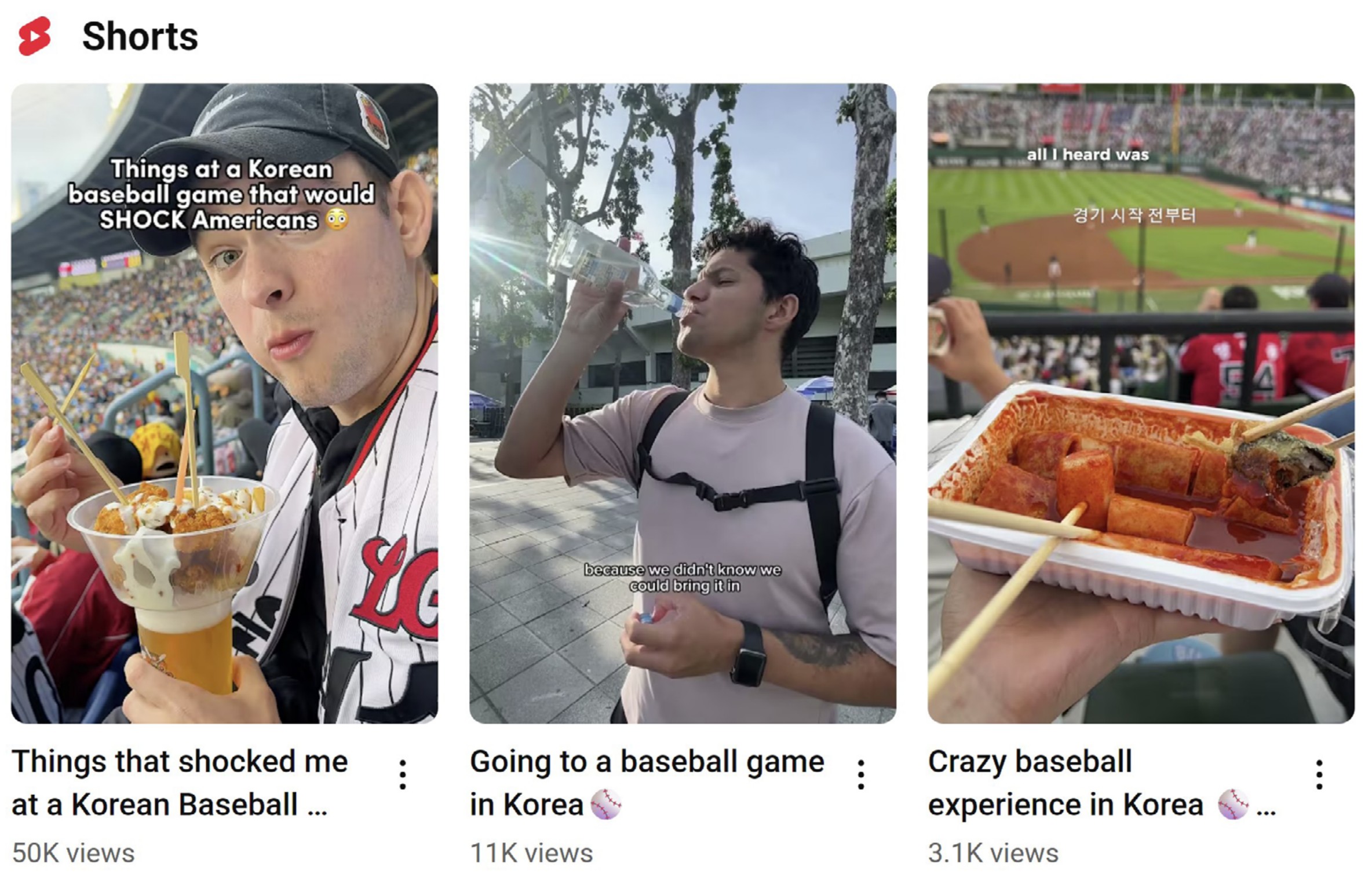
Source: YouTube
Recognizing this potential, the Korea Tourism Organization (KTO) took its first official step in 2025 by signing an agreement with the Seoul-based Kiwoom Heroes to attract international visitors through “K-baseball cheering culture.” This partnership produced the first inbound travel package incorporating KBO games, with a successful pilot in which 104 Taiwanese high school students visited Gocheok Sky Dome to experience the unique cheering culture. The initiative signaled the government’s acknowledgment that the KBO League is not merely domestic entertainment, but a distinctive and competitive tourism product capable of enhancing Korea’s international appeal.
This momentum also presents new opportunities for non-metropolitan regions. While current products center on Seoul’s accessible teams, growing awareness of K-baseball tourism may drive international fans to explore regional franchises and their distinctive cheering cultures. For example, demand is likely to emerge for experiencing the iconic “Busan Seagull” chants at Sajik Stadium or the passionate atmosphere of KIA Champions Field in Gwangju. Accordingly, local governments and clubs outside the capital should proactively collaborate with KTO and inbound travel agencies to design and promote “K-baseball regional tourism packages” that showcase local identity. Such efforts could broaden Korea’s inbound tourism base and channel international visitor flows beyond the Seoul metropolitan area.
The Role of Clubs and Municipalities/DMOs in Revitalizing Regional Tourism
The preceding analysis confirmed that professional baseball holds significant potential as a driver of regional tourism. However, such a transformation can only be realized when supported by structures jointly designed by cities, clubs, and industry partners. International cases illustrate diverse approaches—whether through turning stadiums into landmarks, developing travel packages that integrate transport and lodging, or promoting sports tourism at the city level. Building on these insights, we outline how responsibilities might be divided and implemented in the Korean context.
Recommendations for Professional Baseball Clubs
1. Evolving into an “Entertainment Brand”
Clubs should reconceptualize themselves not merely as “sports teams” but as “entertainment brands” that represent their cities. To achieve this, stadiums must be transformed from facilities operating only on game days into year-round landmarks visited by fans and residents alike. As demonstrated in the United States and Japan, this can be achieved through stadium tours, team museums, off-season concerts and events, and upgraded F&B facilities—developing the venue itself into a stand-alone tourism asset. Such initiatives diversify club revenue streams and create a foundation for sustained visitation even on non-game days.
2. Strengthening “Hyperlocal Partnerships”
Beyond large corporate sponsorships, clubs should cultivate hyperlocal partnerships with small businesses. Following the example of Suwon KT Wiz’s “Wiz Family,” collaborations with nearby restaurants, cafés, and lodging providers could yield ticket-plus-local packages that deliver unique experiences to fans while generating tangible spillover benefits for the regional economy. This approach both channels fan consumption in a structured way and offers the most effective means of addressing the issue of “spillover inequity,” ensuring that the economic benefits are more evenly distributed across local stakeholders.
The Role of Regional Governments/DMOs
1. Reframing the Role as “Co-Investment Partners”
Municipalities must regard clubs not as mere “tenants” but as co-investment partners in generating regional value. As shown in recent conflicts between the NC Dinos and the City of Changwon, relationships built on mistrust incur substantial social costs. To prevent this, a permanent consultative body involving clubs, municipalities, DMOs, and local business representatives should be institutionalized to share long-term visions and make joint decisions. Establishing such cooperative governance is essential both to avert potential disputes and to maximize the value of sports tourism assets.
2. Designing Data-Driven, Tailored Strategies
As revealed in the tourism survey, fan stay patterns differ significantly depending on city location and infrastructure. Accordingly, municipalities should avoid uniform approaches and instead design strategies based on data. Cities like Daejeon, close enough to the capital for same-day visits, should emphasize night-time tourism content or special accommodation promotions to encourage longer stays. By contrast, Busan—where a stayover tourism model is already established—could develop advanced offerings aimed at promoting multi-day visits of two nights or more. Differentiating strategies according to the “distance threshold” is therefore key.
3. Commercializing K-Cheering Culture
Inbound sports tourism should be actively fostered as a new growth driver, supported by proactive regional investment. Building on the Korea Tourism Organization’s model, local DMOs should collaborate with clubs and travel agencies to create foreigner-focused tourism products that highlight each region’s unique cheering culture. Such initiatives not only enhance the satisfaction of international visitors but also extend tourist flows beyond Seoul, contributing to more balanced national tourism development.
Conclusion: Professional Baseball as a New Driver of Regional Tourism
This analysis leads to the conclusion that professional baseball games are not merely sporting events, but composite tourism assets that simultaneously stimulate fan mobility, consumption, lodging, sightseeing, and collective urban memory. When hosted in regional cities, baseball has the potential to become a key player in revitalizing local economies, and the milestone of reaching ten million spectators demonstrates that this potential has now crossed a critical threshold into tangible realization.
To harness baseball as a new engine of regional tourism, strategic efforts must first focus on developing stadiums into independent content. This will position them not only as venues for games but also as everyday tourist landmarks. At the same time, the creation of stayover-oriented travel packages, supported by robust transportation and accommodation infrastructure, is essential. Such offerings can systematically convert away-fan mobility into extended local stays, amplifying the spillover effects into the urban economy.
Finally, stable realization of these outcomes requires institutionalized partnerships and governance structures between clubs and municipalities. When clubs assume the role of expanding fan experiences and municipalities function as platforms that connect regional resources, professional baseball can genuinely elevate place branding and serve as a sustainable engine for regional tourism development.
To reference this article, please use the following citation: “Hyo Won Yoon(2025). Beyond the Ballpark: Exploring the Role of Baseball in Regional Tourism, Yanolja Research Insights, Vol.31.”